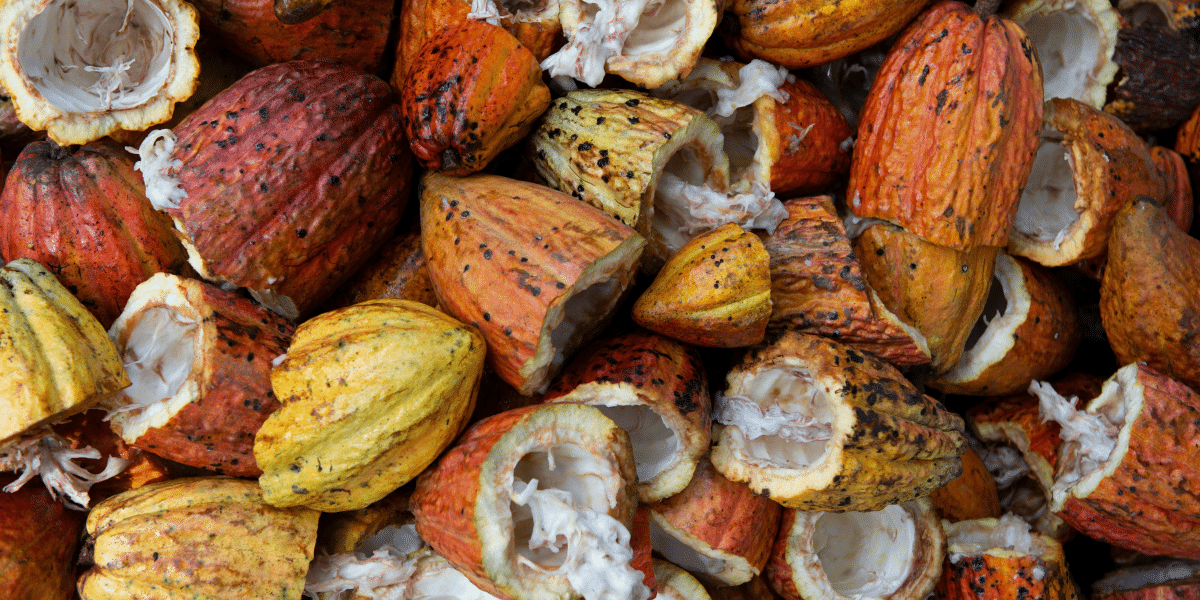Cacao, the raw form of the world’s favorite indulgence—chocolate—has an impressive history and a wide range of health benefits. Known for centuries as a “superfood,” cacao is packed with antioxidants, essential minerals, and natural compounds that promote wellness. In this comprehensive article, we’ll explore the origins of cacao, its significance in ancient cultures, and the scientifically backed benefits of adding it to a balanced diet.
What is Cacao?
Cacao is the minimally processed seed from the cacao tree (Theobroma cacao), native to the tropical regions of Central and South America. It’s loaded with nutrients that support various aspects of health, including antioxidants, magnesium, and fiber. Unlike cocoa, which is typically processed with added sugars, cacao remains close to its natural form, preserving its impressive nutritional value.
The Origins of Cacao: A Journey Through Time
Ancient Roots in Mesoamerica
Historians trace the origins of cacao back to 1500 BCE, when early civilizations like the Olmecs discovered its culinary and medicinal uses. Later, the Maya and Aztec civilizations elevated cacao to an essential element of daily life, using it for medicinal purposes and as a drink.
Cacao’s Role in Mayan and Aztec Culture
For the Maya, cacao was more than a food—it was often enjoyed as a bitter, frothy beverage mixed with spices, and it played a part in special ceremonies. Aztec culture, too, placed high value on cacao, reserving it for nobility, warriors, and for use as currency.
The Introduction of Cacao to Europe
The Spanish introduced cacao to Europe in the 16th century, where it rapidly became a luxury among the elite. European adaptation added sugar, which gave birth to the sweetened version of chocolate we know today. By the 19th century, chocolate was produced in solid form, transforming it into an accessible treat.
Nutritional Composition of Cacao
Cacao is incredibly nutrient-dense, making it a superfood in its own right. Some of its primary nutrients include:
- Magnesium: Crucial for muscle function, heart health, and bone strength.
- Iron: Supports blood health and energy.
- Fiber: Aids in digestion and helps regulate blood sugar.
- Potassium: Essential for maintaining balanced blood pressure.
Rich in Antioxidants
Cacao contains a class of antioxidants called flavonoids, which are known for reducing oxidative stress. Antioxidants in cacao help protect cells, reduce inflammation, and may slow signs of aging.
Unique Compounds and Their Health Effects
Cacao has several beneficial compounds, such as theobromine, a mild stimulant similar to caffeine, and phenylethylamine (PEA), which is linked to mood enhancement. Cacao also contains anandamide, sometimes referred to as the “bliss molecule” for its positive effects on mental well-being.
Health Benefits of Cacao
-
Cardiovascular Health
Cacao’s high flavonoid content can significantly impact heart health by:
- Improving blood flow: Flavonoids help relax blood vessels, reducing the risk of hypertension.
- Lowering cholesterol: Cacao helps reduce LDL (bad cholesterol), protecting against atherosclerosis.
- Reducing blood pressure: Regular intake of raw cacao is linked to lower blood pressure and better vascular function.
2. Mental Health and Mood Enhancement
Cacao stimulates the brain’s production of feel-good neurotransmitters like serotonin and dopamine, which can:
- Improve mood: Compounds in cacao, like anandamide, support relaxation and contentment.
- Reduce stress: PEA and theobromine help boost alertness while mitigating anxiety.
- Enhance cognitive function: The small amount of caffeine and theobromine in cacao enhances focus and clarity.
3. Anti-inflammatory and Immune Support
The antioxidants in cacao combat inflammation, benefiting those with inflammatory conditions such as arthritis. By reducing inflammation, cacao also supports a healthy immune system, helping the body fend off infections and illnesses.
4. Skin Health Benefits
Regular cacao consumption is linked to healthier skin due to its antioxidant properties. Benefits include:
- UV protection: Antioxidants in cacao help protect skin from sun damage.
- Improved hydration: Cacao’s fats and antioxidants support skin hydration, elasticity, and appearance.
- Reduced signs of aging: With its high antioxidant content, cacao may reduce the appearance of fine lines and wrinkles.
Using Cacao in Your Daily Diet
Raw Cacao Powder and Cacao Nibs
The purest forms of cacao include raw cacao powder and cacao nibs. Unlike commercial chocolate products, these forms retain the full nutrient profile of the cacao bean without added sugar or dairy, making them a great addition to a balanced diet.
Differences Between Cacao and Cocoa
While cacao is minimally processed, cocoa is often roasted and processed at higher temperatures, which can reduce its antioxidant content. To maximize health benefits, choose raw cacao or dark chocolate with a high cacao percentage.
Practical Ways to Add Cacao to Your Diet
- Smoothies: Blend cacao powder with fruits, yogurt, or milk for a nutrient-dense smoothie.
- Baked Goods: Use cacao powder as a healthier alternative to cocoa powder.
- Toppings: Sprinkle cacao nibs on oatmeal, yogurt, or salads for added texture and flavor.
For quality cacao products that retain their health benefits, check out Suyana’s cacao offerings, which are sustainably sourced and rich in natural goodness.
Ethical and Environmental Considerations
Sustainable Cacao Farming
Cacao farming often impacts tropical ecosystems, but sustainable and eco-friendly practices can reduce this footprint. Organic and shade-grown cacao farming helps conserve biodiversity and minimize deforestation, making it an environmentally friendly choice.
Supporting Fair Trade Cacao
Choosing fair trade cacao supports ethical production practices, ensuring that farmers receive fair compensation. Supporting fair trade cacao helps protect communities, encouraging better labor standards and reducing economic exploitation in the industry. For ethically sourced cacao products, consider Suyana’s cacao collection.
Potential Risks and Considerations
Caffeine Content and Tolerance
Although cacao contains less caffeine than coffee, those who are caffeine-sensitive should consume it in moderation. Cacao’s natural stimulant properties are usually mild but may cause jitteriness in high amounts.
Moderation and Potential Side Effects
Cacao offers many health benefits, but it’s best consumed in moderation to avoid unwanted effects like digestive discomfort. Limiting intake to a few tablespoons of raw cacao per day ensures safe, beneficial use.
FAQs
What distinguishes cacao from cocoa?
Cacao is the raw, less-processed form of the bean, while cocoa refers to the processed version, which is often roasted and used in various chocolate products.
How much cacao is recommended per day?
1–2 tablespoons of raw cacao powder per day provides ample health benefits without the risk of overconsumption.
What are the key health benefits of cacao?
Cacao supports heart health, improves mood, boosts immunity, and benefits the skin due to its rich antioxidant profile.
Does cacao improve mood?
Yes, cacao’s natural compounds promote the release of mood-enhancing neurotransmitters like serotonin and dopamine.
Is there a difference between raw and processed cacao?
Raw cacao retains a higher level of nutrients and antioxidants than processed cacao, which often loses some of its beneficial compounds during heating.
Is cacao safe for children?
Yes, in moderation. Due to its mild stimulant effects, it’s best to limit children’s cacao consumption to small amounts.
Conclusion
From its origins in ancient Mesoamerica to its popularity as a modern-day superfood, cacao has a rich history and an array of health benefits. Whether enjoyed in its raw form, as dark chocolate, or as part of a nutritious diet, cacao provides support for cardiovascular health, mental wellness, immune function, and skin vitality. Embrace the benefits of this natural powerhouse by integrating it into your daily routine, and choose ethically sourced options like those from Suyana for a responsible, quality experience with every bite.
Disclaimer: The information provided in this article, “The Origins and Health Benefits of Cacao: Discovering Nature’s Nutrient-Rich Superfood,” is intended for educational and informational purposes only. It is not a substitute for professional medical advice, diagnosis, or treatment. The health benefits and nutritional information discussed herein are based on general research and should not be considered conclusive. While cacao may offer various health advantages, individual responses can vary, and its consumption should be approached in moderation. Always consult a qualified healthcare provider before making any changes to your diet, especially if you have existing medical conditions, are pregnant, or are on medication.
Published by: Khy Talara



















